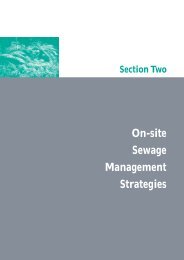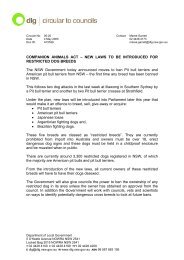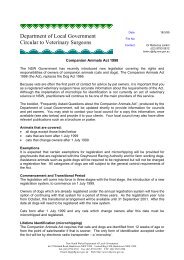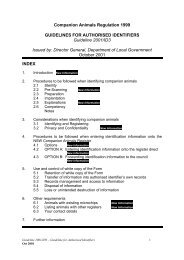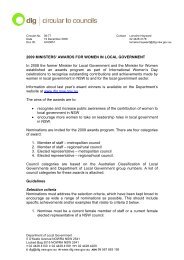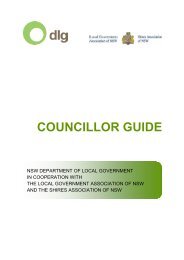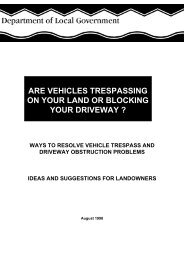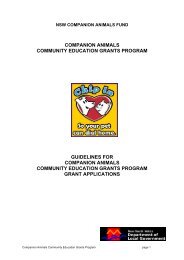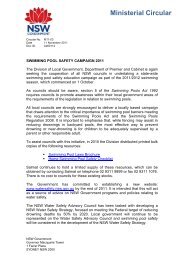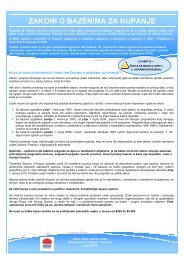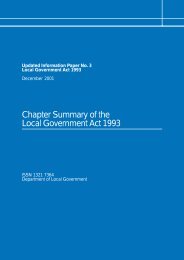Integrated Planning and Reporting Manual - Division of Local ...
Integrated Planning and Reporting Manual - Division of Local ...
Integrated Planning and Reporting Manual - Division of Local ...
Create successful ePaper yourself
Turn your PDF publications into a flip-book with our unique Google optimized e-Paper software.
2. THE COMMUNITY STRATEGIC PLAN<br />
Assessment example: Environmental Management<br />
The new planning <strong>and</strong> reporting framework has elevated environmental management to a strategic<br />
level <strong>and</strong> extended the planning timeframe by including it as a key component <strong>of</strong> the 10-year<br />
(minimum) Community Strategic Plan.<br />
It is important that councils recognise that they will still need to prepare a State <strong>of</strong> the Environment<br />
report at the conclusion <strong>of</strong> each Council term. This will entail gathering information about the local<br />
environment, assessing this information, considering relevant issues <strong>and</strong> suggesting responses to<br />
these issues in order to inform Council’s long-term plans.<br />
The new framework shifts the focus away from reporting on prescribed themes <strong>and</strong> moves the<br />
emphasis towards reporting in a way that adequately informs long-term planning. <strong>Reporting</strong> is tied<br />
to whether or not strategic objectives are achieved. It will be up to councils to decide what are the<br />
most relevant environmental themes to consider when preparing information to inform the<br />
Community Strategic Plan.<br />
A list <strong>of</strong> environmental themes that councils might consider to help them identify key local<br />
environmental issues follows. These themes should be used by councils as a starting point to<br />
identifying priorities when developing their Community Strategic Plan:<br />
<br />
<br />
<br />
<br />
<br />
<br />
<br />
<br />
<br />
<br />
<br />
Air<br />
Water<br />
L<strong>and</strong><br />
Biodiversity<br />
Population <strong>and</strong> l<strong>and</strong> use<br />
Energy<br />
Climate<br />
Transport<br />
Noise<br />
Waste<br />
Coastal <strong>and</strong> marine<br />
Councils might also wish to consider the themes identified in the State Natural Resource<br />
Management targets, as well as themes that relate to other environmental issues. For example,<br />
these might include:<br />
<br />
<br />
<br />
<br />
<br />
<br />
<br />
<br />
<br />
<br />
Native vegetation<br />
Native fauna<br />
Threatened species<br />
Invasive species<br />
Riverine ecosystems<br />
Groundwater<br />
Marine waters <strong>and</strong> ecosystems<br />
Wetl<strong>and</strong>s<br />
Estuaries <strong>and</strong> coastal lake ecosystems<br />
Urban water<br />
<br />
<br />
<br />
<br />
<br />
<br />
<br />
<br />
<br />
Soil condition<br />
L<strong>and</strong> management<br />
Population <strong>and</strong> settlement/l<strong>and</strong> use<br />
Air<br />
Heritage<br />
Energy<br />
Climate<br />
Transport<br />
Waste<br />
In determining whether they are achieving the desired outcomes <strong>of</strong> their Community Strategic Plan,<br />
councils will need to identify what environmental monitoring program is required. This program<br />
should inform Council’s State <strong>of</strong> the Environment report.<br />
<strong>Planning</strong> & <strong>Reporting</strong> <strong>Manual</strong> Page 51 <strong>of</strong> 115



